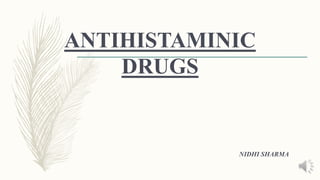Antihistamine.pptx
•Download as PPTX, PDF•
2 likes•80 views
Antihistaminic Drugs
Report
Share
Report
Share

Recommended
Recommended
More Related Content
Similar to Antihistamine.pptx
Similar to Antihistamine.pptx (20)
The Role of Histamine in Radiation’ Toxic Effects .

The Role of Histamine in Radiation’ Toxic Effects .
More from Nidhi Sharma
More from Nidhi Sharma (20)
Sp3 hybridization in alkanes & Sp2 hybridization in alkenes.

Sp3 hybridization in alkanes & Sp2 hybridization in alkenes.
Preparation and standardization of various molar and normal solutions

Preparation and standardization of various molar and normal solutions
Minimization of errors, accuracy, precission, significant figures.

Minimization of errors, accuracy, precission, significant figures.
Different techniques of analysis, Sources of impurities in medicinal agents.

Different techniques of analysis, Sources of impurities in medicinal agents.
Effect of variation in temperature & pH levels on the activity of salivary am...

Effect of variation in temperature & pH levels on the activity of salivary am...
Recently uploaded
Recently uploaded (20)
Disentangling the origin of chemical differences using GHOST

Disentangling the origin of chemical differences using GHOST
All-domain Anomaly Resolution Office U.S. Department of Defense (U) Case: “Eg...

All-domain Anomaly Resolution Office U.S. Department of Defense (U) Case: “Eg...
Chemical Tests; flame test, positive and negative ions test Edexcel Internati...

Chemical Tests; flame test, positive and negative ions test Edexcel Internati...
Nightside clouds and disequilibrium chemistry on the hot Jupiter WASP-43b

Nightside clouds and disequilibrium chemistry on the hot Jupiter WASP-43b
Forensic Biology & Its biological significance.pdf

Forensic Biology & Its biological significance.pdf
Pulmonary drug delivery system M.pharm -2nd sem P'ceutics

Pulmonary drug delivery system M.pharm -2nd sem P'ceutics
Seismic Method Estimate velocity from seismic data.pptx

Seismic Method Estimate velocity from seismic data.pptx
Formation of low mass protostars and their circumstellar disks

Formation of low mass protostars and their circumstellar disks
SAMASTIPUR CALL GIRL 7857803690 LOW PRICE ESCORT SERVICE

SAMASTIPUR CALL GIRL 7857803690 LOW PRICE ESCORT SERVICE
Kochi ❤CALL GIRL 84099*07087 ❤CALL GIRLS IN Kochi ESCORT SERVICE❤CALL GIRL

Kochi ❤CALL GIRL 84099*07087 ❤CALL GIRLS IN Kochi ESCORT SERVICE❤CALL GIRL
Recombinant DNA technology (Immunological screening)

Recombinant DNA technology (Immunological screening)
Antihistamine.pptx
- 2. Histamine- – Histamine is an organic nitrogenous compound involved in local immune responses, as well as regulating physiological function in the gut and acting as a neurotransmitter for the brain, spinal cord, and uterus. – Histamine is involved in the inflammatory response and has a central role as a mediator of itching. – Histamine - a chemical found in some of the body's cells - causes many of the symptoms of allergies, such as a runny nose or sneezing. When a person is allergic to a particular substance, such as a food or dust, the immune system mistakenly believes that this usually harmless substance is actually harmful to the body.
- 3. . • Once formed, histamine is either stored or rapidly inactivated by its primary degradative enzymes, histamine-N-methyltransferase or diamine oxidase. • In the central nervous system, histamine released into the synapses is primarily broken down by histamine-N-methyltransferase, While in other tissues both enzymes may play a role. Several other enzymes, including MAO-B and ALDH2, further process the immediate metabolites of histamine for excretion or recycling. • Histamine is derived from the decarboxylation of the amino acid histidine, a reaction catalyzed by the enzyme L-histidine decarboxylase. It is a hydrophilic vasoactive amine.
- 4. • Bacteria also are capable of producing histamine using histidine decarboxylase enzymes unrelated to those found in animals. A non-infectious form of foodborne disease, scombroid poisoning, is due to histamine production by bacteria in spoiled food, particularly fish. • Fermented foods and beverages naturally contain small quantities of histamine due to a similar conversion performed by fermenting bacteria or yeasts. Sake contains histamine in the 20–40 mg/L range; wines contain it in the 2–10 mg/L range.
- 7. Antihistaminic drugs- – Antihistamines are drugs which treat allergic rhinitis and other allergies. – Antihistamines can give relief when a person has nasal congestion, sneezing, or hives because of pollen, dust mites, or animal allergy. – Antihistamines are usually for short-term treatment. Chronic allergies increase the risk of health problems which antihistamines might not treat, including asthma, sinusitis, and lower respiratory tract infection. The Two largest classes of antihistamines are- 1. H1-antihistamines 2. H2-antihistamines. H1-Antihistamines- They act by binding to histamine H1 receptors in mast cells, smooth muscle, and endothelium in the body as well as in the tuberomammillary nucleus in the brain.
- 8. They are used to treat- • Allergic reactions in the nose (e.g., itching, runny nose, and sneezing). • Insomnia. • Motion sickness or vertigo caused by problems with the inner ear. H2- Antihistamies- They bind to histamine H2 receptors in the upper gastrointestinal tract, primarily in the stomach. They are used to treat- • Gastric acid conditions (e.g., peptic ulcers and acid reflux).
- 9. Group Generation Drug Uses Characteristics H1 antihistamines First •Dimetindene •Diphenhydramine •Meclizine •Doxylamine •Promethazine •Clemastine •Dimenhydrinate •Brompheniramine •Hydroxyzine •Antiemetic agent •Sedative agent •Anaphylactic shock •Antiallergic agent • Allergic rhinitis and conju nctivitis • Contact dermatitis • Hay fever, urticaria, an gioedema, and rhinorrhea •Motion sickness •Strong sedative action •Anticholinergic side effects Second •Loratadine (desloratadine ) •Cetirizine (levocetirizine ) •Azelastine •Fexofenadine •Antiallergic agent •Adjuvant treatment in anaphylactic shock •Non-sedative/mildly sedative H2 antihistamines •Ranitidine •Cimetidine •Famotidine • Reduce production of stomach acid •Usually used as a second- line treatment, or in combination with PPIs Classification of Antihistaminic Drugs-
- 10. Mechanism of Action- – Blocks action of histamine at receptor – Competes with histamine for binding – Displaces histamine from receptor
